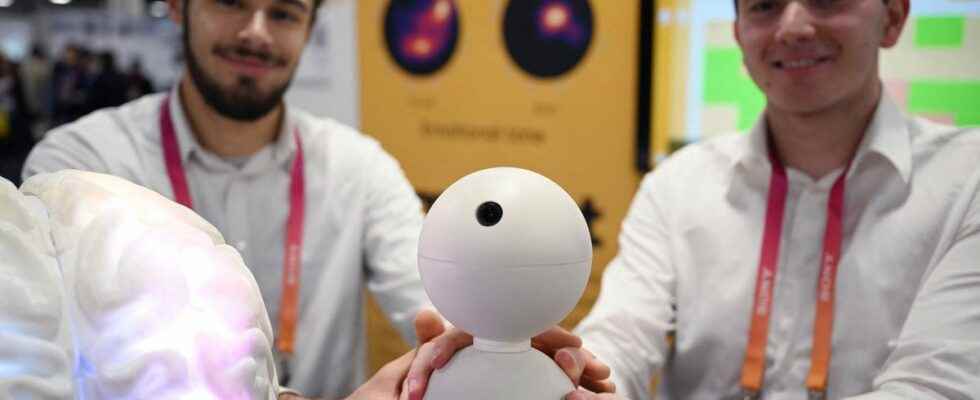Published on
Updated
Reading 3 mins.
“It’s an emotional thermometer”, summarizes Antony Perzo about Emobot, a device capable of analyzing human emotions, one of the latest fields of application conquered by artificial intelligence (AI) at CES, the Las Vegas Tech Show.
Emobot, which resembles a speaker or a minimalist sculpture, makes “continuous emotional watch“Thanks to a camera and microphones, explains the young technological director of this French company.
It is used to detect possible psychiatric disorders in the elderly, such as depression or anxiety.
Placed on a piece of furniture, the robot spends its day monitoring facial expressions, the person’s movements, the tone of his voice to identify any significant changes in behavior and thus avoid emergency hospitalizations.
Antony Perzo and the three other co-founders of Emobot hope to provide an answer to the risks associated with loneliness and medical desertification.
Their device, already tested in nursing homes and in private homes, should make it possible to adjust treatments and therapies without waiting for the next visit from the psychiatrist.
Algorithms are ableanalyze facial microexpressions“which reflect human emotions, themselves a mirror of our”psychological and psychiatric state“, details the engineer.
In the field of health, AI, capable of collecting and analyzing large volumes of data in real time, has long been used to perform many diagnoses, from cancers to urinalysis.
“As humans, we simply cannot process all the information we generate. We need help“, notes Steve Koenig, vice-president in charge of research at the Consumer Technology Association (CTA), which organizes the CES.
Body, Mind, AI
The expression “artificial intelligence” is questioned by many scientists, who see it above all as a marketing tool for companies. At CES, from toothbrushes to tractors, there are few gadgets and services that don’t have AI.
Nufa is defined for example as a “pioneer of AI body transformation“: this mobile application offers users to edit their photo to visualize themselves with a slim and athletic body, and motivate themselves to follow a 90-day plan to achieve this result “in real life”.
But the AI”isn’t just a buzzword for winning your CES bingo“, remarks independent analyst Avi Greengart.
This technology”is used in smartphone cameras. In factories to identify defective products. In agriculture to identify weeds and spray them with weedkiller. The AI is here, and there it is.”
Emil Jimenez founded MindBank Ai in a “quest for immortality”, “so that (his) daughter could always ask her daddy a question”.
Its application allows to record its answers to personal questions (for example: “What does love mean to you?”) in order to “save your mind to the cloud forever“.
But beyond this ambition, the service won over its audience on the promise of getting to know yourself better… during your lifetime. The app features a psycho-linguistic model that analyzes users’ words to decode their emotions.
sentimental crowd
AI can also be used to understand crowd emotions. The Ask Polly tool, from the Canadian company Advanced Symbolics, performs market research in minutes.
The user asks him a question — for example, “Is it a good time to buy an apartment?” Where “Should juvenile criminals go to jail?— and the program scans social networks (Twitter, TikTok, Reddit and Instagram) to analyze public opinion, finely and on a large scale.
In 2022, automated creation algorithms caused a stir, in particular those of the Californian company OpenAI with GPT-3 for text generation, and DALL-E for image generation.
The French start-up Imki has designed a sound and light show for the Roman Theater of Orange where the interactive graphics have been made thanks to programs of this kind.
“This allows you to create content quickly with very low production costs. The art director has a very wide choice of images in a very short time“, emphasizes Marie Lathoud, Marketing Director of Imki.
She sees in AI a tool at the service of artists.
Saket Dandotia, COO of Magnifi, acknowledges that generative AI represents a “threat to designers, whom she will replace“, like robots in factories.
His team created Strobe, an automated video creation software. “For us, AI is a huge opportunity, which will transform the entire creative industry“, he indicated.
